QCF: Pokémon Alpha Sapphire/Omega Ruby
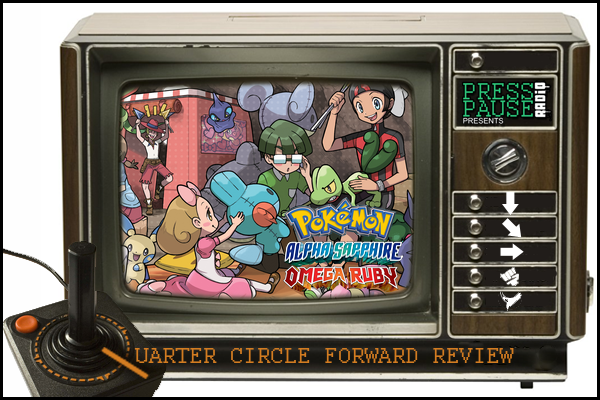
 n what has gradually bloomed into somewhat of a subtle tradition from the gaming giant since the Gameboy Advance’s prime, the Big N has enlisted their subsidiary Game Freak, into unleashing yet another modern revamp of a past chapter out of their golden child’s past, for the latest incarnation of Nintendo’s pocket hardware.
n what has gradually bloomed into somewhat of a subtle tradition from the gaming giant since the Gameboy Advance’s prime, the Big N has enlisted their subsidiary Game Freak, into unleashing yet another modern revamp of a past chapter out of their golden child’s past, for the latest incarnation of Nintendo’s pocket hardware.
While last year’s stellar X and Y entries went on to prove why the Pokémon brand is still a household name though, the inevitable remakes of franchise’s Ruby and Sapphire generation that we anticipated has sadly failed to keep the momentum that those previous titles had lent them.
No, what Alpha Sapphire and Omega Ruby does instead is quite the opposite, it falls victim to a wonted flaw that has infrequently plagued Pikachu and his Poképals in more recent years of the now tenured property—complete and utter fatigue.
Granted, the notion of criticizing the degree of familiarity within a remake of classic title does seem a bit inane, absurd even; but in this case, it’s well-founded. In the grand scheme of the title’s design, Alpha Sapphire and Omega Ruby hardly adds anything new or refreshing to what’s ostensibly is the exact same game engine that we all experienced over a year ago.
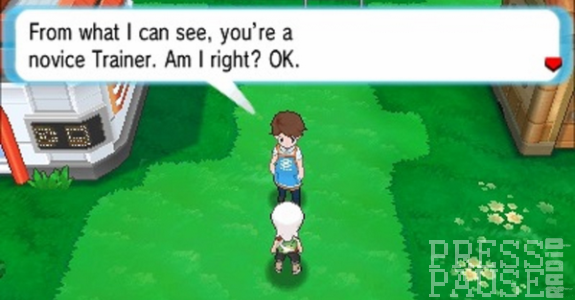
Let’s not get things twisted here; piloting third generation of Pokémon in a vehicle that’s built out of the new features and improved mechanics of X/Y does an admirable job of smoothing over a margin of the rough patches that Ruby and Sapphire were known for.
The returning advancements include the new Experience Share that introduced a new distribution where every monster on your team would earn a consolidative cache of XP points after every battle, including battle against caught beats in the wild, allowing for a more efficient means of pocket monster development. And then there’s the handy PokéNav , the in-game utility tool that helped streamline a majority of the dynamics that define Pokémon gameplay like Super Training and the Player Search network and all of its connective features are available within the early onset of your journey, Hell even the Pokémon Bank is immediately available.
These features are indeed a breath of fresh air for a memory lane that’s paved off of the rose-tinted adulation of the rabid fan following that holds it high regards, but it arguably has more of a negative impact on the antiquated foundation of Ruby and Sapphire and it’s irrefutably troubled pacing. One of the few new elements that the remakes do add is easily one of the most redeeming qualities to be found in this revision; the Pokédex Nav search.
Once in a good while or so when wandering in, or around the untamed yards of grass, you’ll occasionally encounter a visible silhouette of a monster rustling about in specified spot within the area to come across.
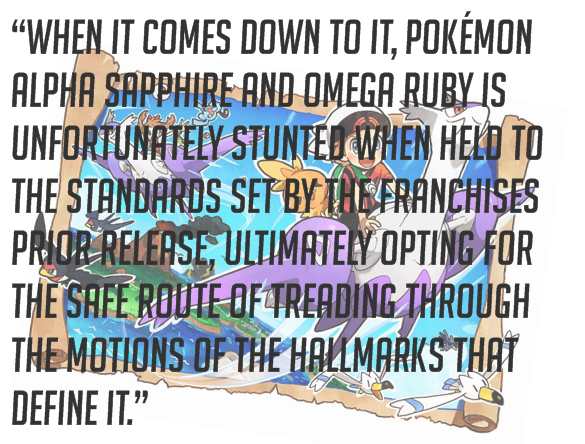 This new feature adds a new layer to the iconic thrill of hunting and catching intrepid battle beasts out of the tall thickets of grass that harbors them, as it players will not only need to gently approach these shrouded creatures, but the incentive that explicitly comes with happening upon rustling monsters on screen. Each of these moments come with the opportunity to investigate these creature at glance without directly revealing them, analyzing and relaying the more nuanced traits that the awaiting creature features like their individual nature, skill, and even their first attack. The dynamic of revealing is particularly remarkable as there was a rare chance that the beast would contain an uncharacteristic attack, one that the monster in question wouldn’t normally utilize, like an Absol who would know Ice Fang for instance.
This new feature adds a new layer to the iconic thrill of hunting and catching intrepid battle beasts out of the tall thickets of grass that harbors them, as it players will not only need to gently approach these shrouded creatures, but the incentive that explicitly comes with happening upon rustling monsters on screen. Each of these moments come with the opportunity to investigate these creature at glance without directly revealing them, analyzing and relaying the more nuanced traits that the awaiting creature features like their individual nature, skill, and even their first attack. The dynamic of revealing is particularly remarkable as there was a rare chance that the beast would contain an uncharacteristic attack, one that the monster in question wouldn’t normally utilize, like an Absol who would know Ice Fang for instance.
The element all in all adds a sense of engagement that the act of searching and catching Pokémon that’s been long missing from the franchise. The DexNav also streamlines the effort even with a visual checklist display of all of the obtained critters you’ve acquired within the immediate area, adding a new rewarding flair of satisfaction to that arbitrarily gratifying urge to catch them all.
Indeed, there’s no denying the charm of re-experiencing that comforting scene of riding in the back cargo hold of your family’s Moving Van, as it gently rumbles and tumble on the rough terrain of the road that leads to your new life in Hoenn—there’s no shortage to these moments.
However, it isn’t long after the span of a few hours into the introductory phases of the adventure, that the appeal of the memorable sights and monsters begins to quickly fade into the ether, and the heavy amount of nostalgia that the game fuels it’s drive starts to hold it back. This is where the divide of the X & Y vehicle is drawn.
The reality that updated mechanics are merely nothing more than a fresh coat of paint and new dashboard with GPS that’s been slapped onto an old beat up car, which ultimately doesn’t help it drive any better than it could barely even do when it was in it’s prime.
The world of Hoenn is still a tedious, frustrating, chore of a world to explore and travel. The further you chart into its almost labyrinthine plots of filler scenic routes and needlessly complex courses that circle in and out of towns three to four times over , do you slowly begin to resent what just may questionably be one of the most charming dynamics that the Pokémon titles have to offer; exploring a distinctive and awe-inspiring world. The issue is further compounded by the saturation of HM moves that play external role in progressing through the gated areas of the over-world.
Sure, moves like Surf, Fly, and Strength, and maybe even rock smash and cut are an innocuous staple to the sensation that exploring the unique regions of the Pokémon world, but when you add in the additional nonsense of rock climb, dive, and waterfall, and so much more, it begins to wears bit thin. The diversity of these moves almost hinder players by limiting how they conduct the selection of their team roster by needing to accommodate for the HM mechanic, and still inexcusably flawed by the need to fill one of the vital move slots among the sparse four you’re allowed with each partner.
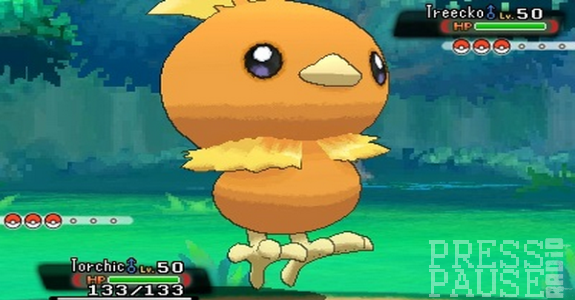
While I’d talk about the new Mega Evolutions here, they’re introduced at such poorly timed moment of the game’s flow that it’s almost inconsequential tpo the overall experience. The Primal Reversion that’s also touted is just as lame as the hokey DNA Splicing and Reveal glassing from the prior generations, there’s nothing innovative about what it does, or the appearance it gives to the trademark legendaries of the generation.
The contest feature that the iteration was infamous for introducing is just forgettable and disappointing as it was twelve years ago, and the new Cosplay Pikachu feature that endorses it is equally just as shallow.
Though it is worth crediting that the secret base is revamped around the facilities of connectivity that this new age of hardware can afford it, and the act of sharing bases via QR codes and street-passing online makes the feature even more exciting than it originally was.
In addition to the old setup where you can capture and claim the bases of players that have connected and submitted their humble shelters in the network vicinity around you, players can also host and run their custom Gyms and prizes. Networking and mingling with the bases of other can even grant you access into enlisting NPC proxies of your online friends to hangout in your secret base, residing within your clubhouse as a secret pal.
When it comes down to it, Pokémon Alpha Sapphire and Omega Ruby is unfortunately stunted when held to the standards set by the franchises prior release, ultimately opting for the safe route of treading through the motions of the Hallmarks that define it. Which, not to say it isn’t a bad thing at the core of things, but it also isn’t doing any favors to a brand that’s beginning to show it’s age either.
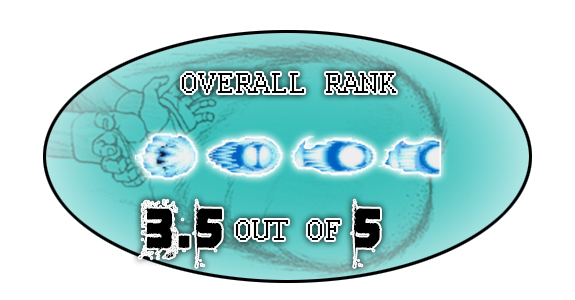





 GeorgieBoysAXE
GeorgieBoysAXE




